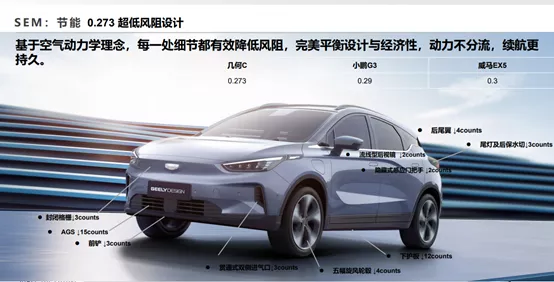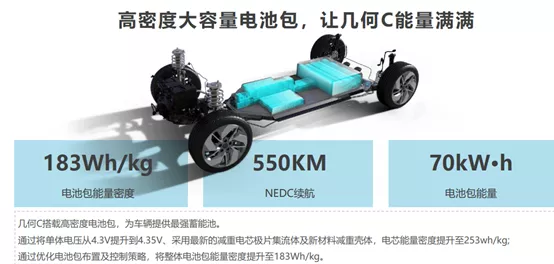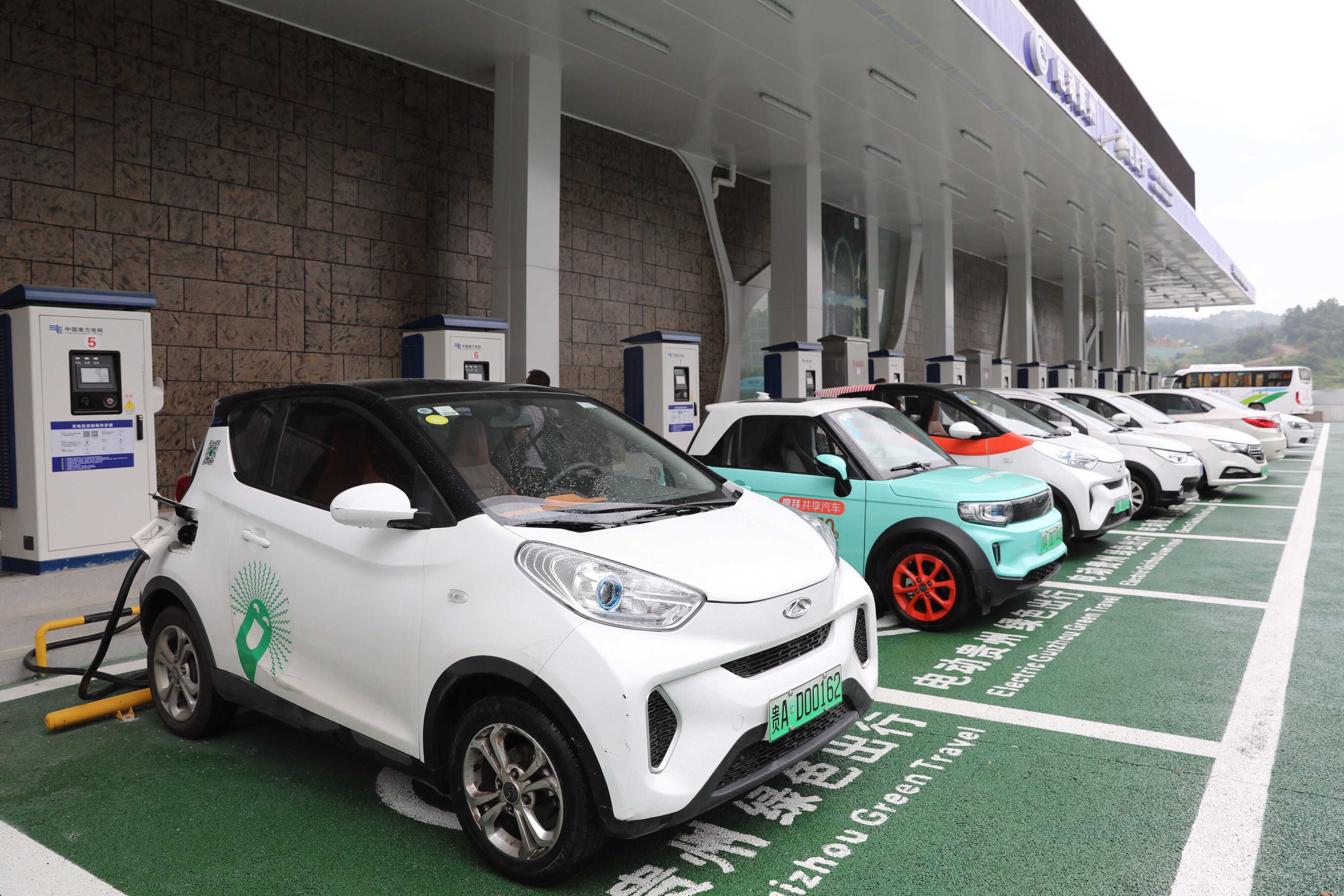The problem of reduced electric vehicle (EV) range has always been a sore point for EV owners. Range can be affected by many factors such as winter weather, high-speed driving, use of air conditioning, and even windy or rainy days.
Range, once mocked by car owners to be the pre-discounted price shown on a Taobao shop, is now considered to be the discounted price after all the factors affecting range have been taken into account.
The practice of reducing range has become a hidden rule in the industry, leaving consumers to foot the bill.
This should not be the case. Why should consumers be the sacrificial lambs?
However, there are automakers who are devoting research and development resources to maximize EV range and make the stated range the actual range.
In mid-March, the real-world EV range test was held in Shenzhen, in which real EV owners participated. Among all the participating models, the Geely Geometry C traveled 1.062 times the stated range, making it the only model to exceed the stated range.
This is not the first time that Geely Geometry C has performed such a miracle. In last year’s winter range race in Beijing, it won the championship with a score of 94%, surpassing the second-place finisher by 10%.
The question is, how did Geely Geometry C achieve this?
The answer lies in its systematic “soft power”.
While the Geely Geometry C won the winter Beijing range test with its unique “hard power” – its heat pump air conditioning system, it won again in Shenzhen with its advanced “soft power” – its SEM intelligent energy management system.
Traditionally, various components like the battery management system (BMS) and the electronic control unit (ECU) in EVs have separate control programs that operate independently.
However, in the compact pure electric SUV, Geely Geometry C has taken the lead in using the three-in-one integrated electric drive system, which integrates and optimizes various control units in software control logic.The SEM Intelligent Energy Management System has five functions for energy control from a system perspective: energy boosting, energy control, energy recovery, energy saving, and energy storage. After systematic integration and software optimization, SEM Intelligent Energy Management System is in a leading position in energy boosting, energy control, and energy recovery in the industry.
As an example of energy control, the driving range of an electric vehicle with low power battery is often less impressive than when it is high in power. In the SEM Intelligent Energy Management System, the ECO+ super energy-saving mode is designed for this special condition.
When the vehicle’s remaining power is low, and the owner drives the car around to find a charging station, the ECO + super energy-saving mode can be activated. By reducing the power consumption of non-essential components such as air conditioning and seat heating, it prioritizes the remaining power to drive the vehicle forward.
According to the official statement, after the ECO+ super energy-saving mode is enabled, its driving range can be increased by 8%. For the vehicle owner, the increased driving range during low-power driving can allow the vehicle to be driven to the charging station more calmly, without worrying about running out of power on the road.
In the SEM Intelligent Energy Management System, there are also many systematic energy control schemes, such as the integration of battery constant temperature system and battery preheating system, which can better ensure the authenticity of winter driving range.
SEM Intelligent Energy Management System is designed and developed from a systematic perspective on software, and then the software is enabled by the hardware, thereby gaining a leading advantage among competitors.
However, enabling software with hardware also requires sufficient “hard power”.
Compared with “soft power”, the hard power of Geely Auto is equally outstanding.
Geely Auto is unique among its peers in terms of hardware, with many highlights.
One of the highlights is that Geely Auto uses the Bosch iBooster energy recovery system.
iBooster is an energy recovery system designed specifically for electric vehicles. Taking advantage of the energy recovery characteristics of electric vehicles, it integrates mechanical braking with kinetic energy recovery. During the braking process, it can ensure sufficient brake force and convert kinetic energy losses into battery power, which is stored in the power battery.
The Bosch iBooster energy recovery system recovers almost 100% of brake energy, and through brake energy recovery, it can increase driving range by up to 30%.In the same level of vehicle models, only Geometry C comes standard with iBooster energy recovery system.
The second highlight is that Geometry C is the first to adopt a heat pump air conditioning system.

The heat pump air conditioning system has a significant advantage in energy-saving compared to traditional PTC heating air conditioning systems. In the most ideal state, the heat pump air conditioning system is 2.5 times more energy-saving than the PTC air conditioning system.
The biggest problem with traditional PTC thermistor heating air conditioning systems is high energy consumption. If PTC can convert 100% of the electrical energy into heat, then the heat produced by the heat pump air conditioning system is 2-3 times that of the PTC air conditioning system with the same power consumption of 1 kWh.
By adopting the heat pump air conditioning system, Geometry C has shown excellent performance in actual range under winter, spring, and autumn conditions.
The third highlight is Geometry C’s lower wind resistance.
The biggest difference between the actual driving range and the nominal range is the impact of wind resistance on the vehicle’s driving range under real road conditions, which is more complex than in the laboratory.
Slight fluctuations in wind speed can have a significant impact on the driving range. In Shenzhen, located by the coast with gentle breeze, real road driving range testing is more demanding than in the laboratory.
For electric cars participating in endurance competitions, the aerodynamic drag coefficient is an important parameter that affects the driving range.
Geometry C’s aerodynamic drag coefficient is 0.273.

Among the same level of competitors, Geometry C has a relatively low aerodynamic drag coefficient.
On the one hand, Geometry C uses visible configurations such as a fully enclosed grille, hidden door handles, and energy-saving wheels to improve the aerodynamic drag coefficient.
In areas that consumers cannot see, the optimization of the fully enclosed chassis protective plate, AGS, and other details further reduce the aerodynamic drag coefficient of Geometry C.
According to official data, Geometry C can reduce the aerodynamic drag coefficient by 12 counts through only one fully enclosed chassis protective plate.
The fourth highlight is weight reduction.
In terms of weight reduction, Geometry C adopts the strategy of combining power battery with vehicle lightweight design.
The power battery belongs to the dead weight of the vehicle, and the lighter the better. Therefore, Geometry C uses Ningde Times’ latest Ni55 high-performance ternary lithium battery.
 The Ni55 ternary lithium battery has a single cell energy density of up to 253Wh/kg, and the energy density of the battery pack can reach 183Wh/kg after being composed into a power battery.
The Ni55 ternary lithium battery has a single cell energy density of up to 253Wh/kg, and the energy density of the battery pack can reach 183Wh/kg after being composed into a power battery.
Using Ni55 high-performance ternary lithium batteries, the Geometry C can pack more batteries into the same weight of the power battery pack than its competitors. With a power battery pack capacity of up to 70kWh, 1.3 times that of its competitors, it increases the driving range by 100km.
In addition to using steel-aluminum body, the Geometry C also utilizes new technologies such as the application of aluminum alloys and composite materials to achieve weight reduction.
In key parts such as the front crash beam, powertrain support, battery shell, and steering knuckle, the Geometry C adopts aluminum alloy to improve the driving quality of the vehicle.
For non-safety related components, the Geometry C uses material technology to reduce weight, such as with the use of composite materials for the front module and suspension support. The composite materials possess a higher strength, hardness, and support compared to traditional steel and ABS plastic. The excellent corrosion resistance of composite materials not only reduces weight but also improves durability.
Through technical innovation, the Geometry C reduces weight in key parts such as the hollow drive shaft, which reduces power transmission loss.
By combining software and hardware, the Geometry C achieves a real driving range through multiple approaches, such as using new power batteries, thermal pumps, low drag design, and weight reduction.
This real driving range shows the value proposition of the Geometry brand. The Geometry C has won the real driving range competition for electric vehicles for two consecutive years, proving its strong driving range in both winter and spring seasons.
Geometry has launched several models including Geometry A and Geometry C within three years. Recently, Geometry opened the pre-sale of its new car, Geometry A Pro, with the slogan “True Range Pre-sale.”
Is the real “range” of such a car reliable? Currently, Geely’s official website claims that the Geely A Pro has two different versions of range: 430km and 600km.
As Geely A Pro adopts the same three-electric power system as Geely C, it is not groundless to claim the real “range” of Geely A Pro during presales, based on the performance of Geely C.
From Geely A to Geely C, and to Geely A Pro, the real range of Geely models has been truly reflected. This not only shows the competitiveness and marketing strategies of the models but also reflects the brand’s value proposition.
Considering the real range performance of these three Geely models, the official website can give much higher range numbers than what is claimed, and the real range is still competitive with that of other car models.
However, Geely chose to provide restrained range numbers to consumers, which enables them to experience the reliable range during actual use, and produce unexpected value and experience.
In turn, consumers can extrapolate that Geely’s range is trustworthy, meaning that other performance, functionality, and service claims made by the brand are also reliable. Brands that lie about their range can also lie about their other claims and promises, making it difficult for customers to trust them.
As a result, consumers will place more trust in the Geely brand, and are more willing to continue purchasing from it, or recommend it to friends.
Overall, this is a branding proposition for truthfulness, pragmatism, and long-termism.
At present, the new energy vehicle industry in China has fears of “false advertising” and “over-optimism.” In the midst of hyperbole, exaggeration, and shifting blame in the “hot” industry, there are concerns.
Electric vehicles are gradually moving out of restricted cities for cars and entering the mainstream consumer market. If car companies keep exaggerating the range, and focus on partial advertising, without considering actual range, it not only might lead to the brand being spurned by consumers but also might result in the public having a negative impression of electric vehicles, negatively affecting their promotion and popularity.
Electric vehicles are gradually winning favor among car consumers. Brands like Geely C that promote genuine range, and provide a reliable range to solve range anxiety. This is not only good for Geely’s brand reputation but also for electric vehicles as a whole.
The Chinese electric car industry needs more brands like Geely.
This article is a translation by ChatGPT of a Chinese report from 42HOW. If you have any questions about it, please email bd@42how.com.
